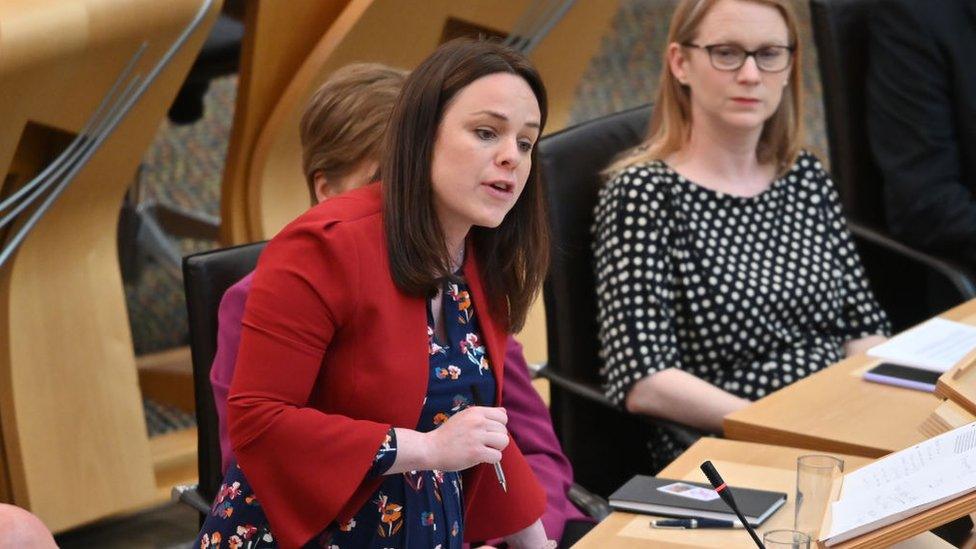Why more Scots pay higher income tax
- Published

New calculations show that the number of people on higher rate income tax, charged at 41%, is rising in only 11 years from 7% of all Scottish taxpayers to 17%.
The Scottish Fiscal Commission calculates that freezing the threshold for higher rate tax is costing someone on £60,000 more than £600 this year, rising above £1,300 a year five years from now.
That is along with an anomaly in National Insurance which leaves higher rate earners facing a marginal tax rate of more than 54% on each additional pound earned.
It's called fiscal drag, and it's one of the most effective ways of raising tax without people noticing.
With inflating prices and pay, it becomes all the easier for governments to rake in extra cash for people as their earnings rise.
And according to figures published this week, it's on course to catch nearly one in six Scottish tax-payers in its net.
One reason people tend not to notice or complain too loudly is that it tends to accompany a pay rise, and most of us like those - even if they're not keeping up with prices.
Above £12,570 in earnings, you pay Scottish income tax, starting at 19p in each pound earned.
As earnings rise, you pay more on higher tranches; 20% of each pound earned between £14,700 and £25,700.
There's an intermediate rate, which you won't find in the rest of the UK: tax is at 21% from £25,700 up to £43,662.
It's then that fiscal drag pulls earners into a much higher tax bracket, at 41% of each extra pound earned.
To inflate or not?
So far, fair enough. It's a progressive system, and is often justified at a higher rate than the rest of the UK (paying 40%) because, in Scotland, everyone gets more stuff without paying for it directly, from student tuition to dental checks and elderly care.
But this isn't about comparison with the rest of the UK, which has its own version of fiscal drag. This is about the application of inflation in Scotland.
The Scottish Fiscal Commission (SFC) has set out figures that no longer assume that higher tax rate threshold will rise with inflation.
It previously kept assuming that, and found that it doesn't then happen. So this year, the independent SFC asked the Scottish government: should we forget inflation, and freeze that threshold?
The Scottish government said yes.
Dragged up
The consequence is illustrated by the SFC's tables, also published this week. They show there are more than 4 million tax-payers in Scotland, rising by 48,000 between now and 2027.
At present, some 478,000 tax-payers are on the higher rate, with earnings that mean they have to pay 41% tax on each extra pound earned.
In the past two years, that's an increase of 94,000. Next year, it will go up by 33,000, then another 42,000, then by a further 54,000 and 47,000 the year after that. That's fiscal drag.
So by 2027-28, the Fiscal Commission is estimating that 697,000 Scots will be on higher rate tax, up by 313,000 in only seven years.
Whereas 7% of taxpayers paid higher rate in 2016, that has reached 11.8% of taxpayers this year, and the forecast is for that to rise to 17%.
Tax gap
But joining the ranks of the growing minority of higher rate tax is not the only measure of fiscal drag. Once you're in that category, and inflation is not applied to the threshold, the impact mounts up.
To illustrate this, the Fiscal Commission takes someone earning £60,000 - roughly double average full-time pay, so it's a good salary, but hardly the elite 1%.
With the threshold frozen, that person will be paying £653 more in tax this year than they would if the threshold had been raised with inflation.
And so it goes on, the longer the freeze is applied. That gap rises to £1,317 four years from now.

Finance Secretary Kate Forbes outlined the government's spending plans for the next five years on Tuesday
The further cost to the higher rate tax payer is that they're taking a hit on National Insurance Contributions as well. That is paid at 13.25% of earnings up to the point when higher tax rates kick in. NICs then fall to 3.25% (that used to be 1.25 percentage points lower, but it went up in April this year.)
Because that is not devolved, Westminster aligns NICs with its higher threshold for higher rate tax, and that starts at £50,270.
The result for Scots is that they pay 41% tax on earnings above £43,662 and under £50,270, and on top of that, they pay 13.25% NICs - a marginal rate of 54.25% on each pound earned - while taxpayers in England and Northern Ireland are paying 20% income tax on those funds, and a marginal rate of 33.25%.
The plight of those on £43,000-plus is not to the fore at a time of a cost-of-living crisis. Higher earners have coping mechanisms like savings and fewer holidays.
But the cumulative effect of fiscal drag is significant. How it plays politically will be worth watching.
As we learned from this week's spending review from finance secretary Kate Forbes, her choice is for those taxes to go increasingly into Scotland's welfare benefits budget, while public services are squeezed.
